Stainless steel pipes have been a staple in the industrial world for decades. They are known for their strength, durability, and corrosion resistance. However, stainless steel’s ability to withstand rust sets it apart from other types of piping material. Rust is formed when iron reacts with oxygen and water, resulting in the formation of iron oxide. This process weakens metals, causing them to become brittle and eventually break down. However, stainless steel has a high content of chromium that forms an invisible protective layer on its surface, preventing the formation of rust. This article will delve into the enduring excellence of stainless steel pipes beyond rust. We will discuss the benefits of using stainless steel pipes in different industrial applications.
Corrosion resistance
Stainless steel pipes are known for their exceptional corrosion resistance. As mentioned earlier, the high chromium content in stainless steel forms a protective layer on its surface, making it less susceptible to rust and other forms of corrosion, which makes stainless steel pipes ideal for industries dealing with harsh chemicals and corrosive materials. Unlike other metals, stainless steel does not require additional coatings or treatments to prevent corrosion, making it a cost-effective and low-maintenance option.
Stainless steel pipes also resist environmental factors such as extreme temperatures, humidity, and UV exposure, making them suitable for outdoor applications where they are exposed to these elements. For example, in the oil and gas industry, stainless steel pipes are used in offshore drilling rigs, constantly exposed to saltwater and harsh weather conditions.
Strength and durability
Stainless steel pipes have a high strength-to-weight ratio, making them solid and durable, which makes them suitable for structural applications such as building and bridge construction. They can withstand heavy loads and high pressures without deforming or breaking, making them a reliable choice for critical infrastructure.
Stainless steel pipes are also highly resistant to mechanical stress and wear, making them suitable for applications that require frequent handling and movement. They are commonly used in transportation for pipelines and car, truck, and train exhaust systems. The durability of stainless steel pipes also makes them a popular choice in the food and beverage industry, where they can withstand high temperatures, pressure, and frequent cleaning without corroding or degrading.
Hygienic properties
Stainless steel pipes have excellent hygienic properties, making them suitable for use in industries that require strict sanitation standards. The smooth surface of stainless steel pipes prevents bacteria and other germs from adhering to its surface, making it easy to clean and maintain. It makes stainless steel pipes a top choice in the medical and pharmaceutical industries, where maintaining a sterile environment is crucial. They are also commonly used in food processing plants, breweries, and dairy farms.
Stainless steel’s non-porous surface also makes it resistant to corrosion from acidic or caustic substances, making it a safe and durable choice for chemical processing plants. Stainless steel pipes do not release harmful chemicals or toxins into the substances they transport, making them an excellent option for industries dealing with sensitive materials.
Aesthetic appeal
In addition to its functional benefits, stainless steel pipes have aesthetic appeal. They have a modern and sleek appearance, making them a popular architectural and interior design choice. Stainless steel pipes can be polished to a high shine or brushed for a more industrial look. They are also available in different sizes, shapes, and designs, allowing designers to use them in various applications.
Stainless steel pipes are also available in different finishes, including matte, satin, and mirror. This versatility makes them preferred for decorative purposes such as handrails, furniture, and lighting fixtures. The durability of stainless steel also ensures that its aesthetic appeal remains intact over time without fading or rusting.
It is worth mentioning that stainless steel pipes are also environmentally friendly. They are 100% recyclable and can be reused without losing their properties, reducing waste in landfills and pollution from new materials.
Sustainable and eco-friendly
Stainless steel pipes are a sustainable and eco-friendly choice for industries and applications prioritizing environmental responsibility. As mentioned, they are 100% recyclable, making them an environmentally friendly option compared to other materials. The production process of stainless steel also consumes less energy and resources than other metals, reducing its carbon footprint.
The durability of stainless steel also makes it a sustainable choice. It has a long lifespan and requires minimal maintenance, reducing the need for frequent replacements and repairs. It saves resources and reduces the environmental impact of manufacturing new materials.
It is also worth mentioning that stainless steel pipes do not release harmful chemicals or toxins into the environment, making them a safe and sustainable option for industries dealing with sensitive materials.
Cost-effective
Despite its many benefits, stainless steel pipes are surprisingly cost-effective. While the initial cost may be higher than other materials, its durability and low maintenance make it a cost-effective option in the long run. Stainless steel pipes have a longer lifespan compared to other materials, requiring fewer replacements and repairs, which saves money on labor and material costs.
Stainless steel’s corrosion resistance reduces the need for additional coatings or treatments, saving money and time during installation and maintenance. Its low maintenance also means less downtime and production interruptions, making it a cost-effective choice for industries that rely on continuous operation.
Its strength and durability allow thinner walls than other materials without compromising performance or safety, which reduces material costs without sacrificing quality.




